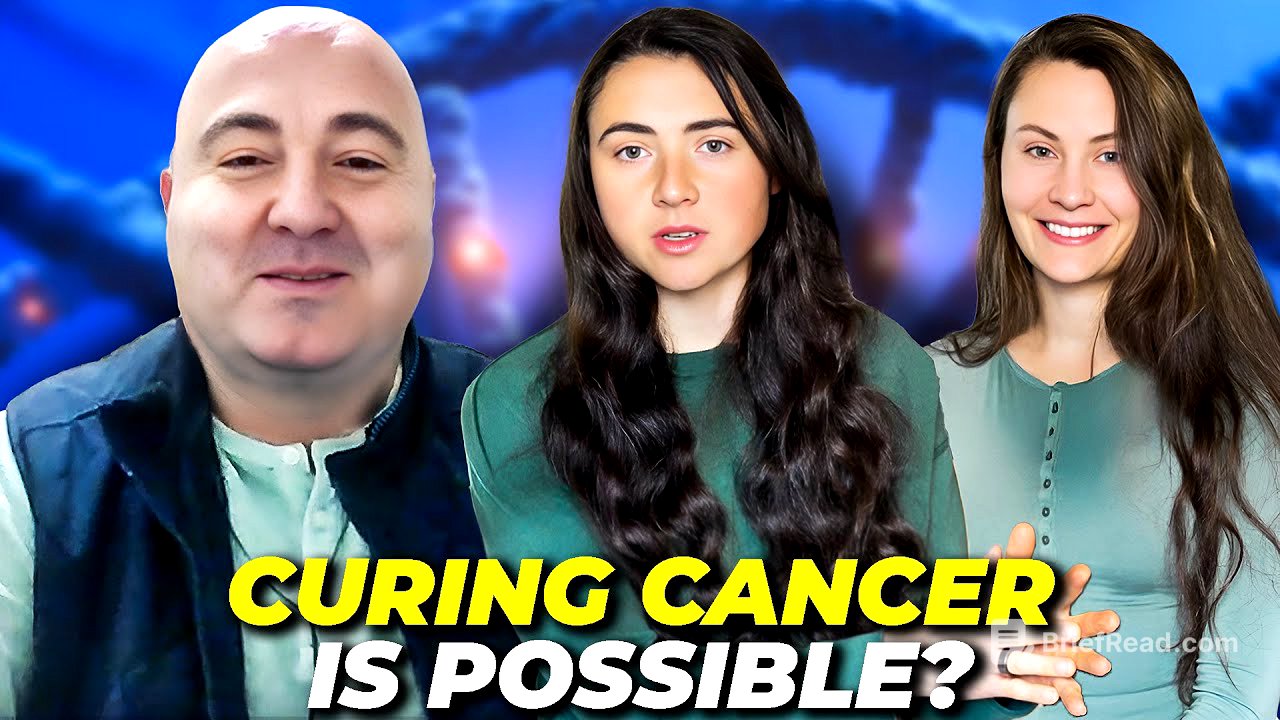TLDR;
This video features a discussion with Georgie about his self-funded cancer studies, which challenge the mainstream model. Key points include:
- Estrogen's role in promoting cancer and how it opposes testosterone.
- The bioenergetic view of cancer, focusing on failed energy metabolism and the Warburg effect.
- The importance of restoring oxidative phosphorylation and the potential of pregnenolone and progesterone in combating cancer.
- The dangers of killing cancer cells and promoting metastasis.
- The myth of androgens in prostate cancer and the benefits of DHT and aromatase inhibitors.
Coming Up [0:00]
Georgie is challenging the mainstream cancer model by demonstrating that estrogen contributes to cancer, and that tumor reversal can be achieved by doing the opposite of mainstream prostate cancer treatments. Ray Peat wrote 30 years ago about estrogen driving cancer metabolism and testosterone opposing estrogen's effects.
Catching Up With Georgie: How Are Things Going? [0:54]
Georgie reports that things are stable, but DC's budget is being cut, potentially affecting police services and raising concerns about a repeat of past riots. Federal government layoffs are impacting the housing market, which could benefit younger generations. Commercial real estate is emptying due to agency closures, further reducing the DC government's revenue.
Why Georgi Self-Funds His Cancer Studies [2:50]
Georgie self-funds his cancer studies due to his fear of the federal funding process, which often comes with strings attached and limits research freedom. He emphasizes the importance of maintaining independence to pursue his own ideas. The current system is more profitable in managing cancer than preventing or curing it.
Bioenergetic View of Cancer Explained [5:24]
The bioenergetic view of cancer suggests that cancer arises from failed energy metabolism, leading cells to rely on glycolysis and the Warburg effect. The body has multiple pathways for energy production, but cancer metabolism relies on the least efficient one. Restoring proper oxidative phosphorylation may offer a way to address cancer.
Wound Healing, Glycolysis, and Cancer Metabolism [7:00]
Glycolysis is important for wound healing, where cells temporarily switch to glycolysis to divide and grow quickly to fill the injury. Once the wound is filled, cells need to differentiate into specific tissues, requiring oxidative phosphorylation to produce differentiating hormones like pregnenolone and progesterone. Constant assault on healthy tissue can cause cells to dismantle their oxidative phosphorylation apparatus and rely solely on glycolysis.
Aspirin’s Role in Cancer Metabolism [9:30]
Aspirin can switch off cancer metabolism in relatively normal cells, causing them to revert to oxidative phosphorylation, and command severely damaged cells to commit apoptosis (controlled self-destruction). Cancer cells are highly alkaline, and aspirin, being an acid, can lower their pH, helping them decide whether to undergo apoptosis or switch back to normal metabolism. Glycolysis, while a backup pathway, is massively upregulated in cancer, occurring outside the mitochondria and producing less ATP and harmful byproducts like lactic acid.
Cancer as a Regression to Primitive Life [14:04]
Cancer can be viewed as a regression to a more primitive version of life, where cells rely solely on glycolysis for energy. This primitive energetic pathway is only sufficient for division and growth, similar to bacteria or fungi. Anything interfering with the symbiotic relationship between mitochondria and the host cell, such as physical injuries or chemical assaults, can lead to this regression.
How Blue Light Damages Mitochondria and Fuels Cancer [16:00]
Exposure to non-ionizing radiation, especially blue light from fluorescent lights and electronic devices, can damage mitochondria. Blue light is toxic to microorganisms, including what mitochondria once were, interfering with the symbiotic relationship between mitochondria and the host cell. This interference can lead the host cell to dismantle the mitochondria, relying solely on glycolysis and promoting cancer.
Updates on Breast and Prostate Cancer Studies [18:52]
Recent studies focus on breast and prostate cancer, which account for the majority of cancers in developed countries. The breast cancer study uses the estrogen receptor-positive MCF-7 cell line. Combinations of B vitamins plus aspirin, 26 DHBA, and pregnenolone are being tested.
How Pregnenolone Reverses Cancer Metabolism [20:11]
An in vitro study four or five years ago showed that pregnenolone performed better than standard treatments for the MCF7 line without causing cell toxicity. Current in vivo studies show that tumor growth has stopped and tumors are starting to regress in animals treated with aspirin plus B vitamins, 26 DHB PA, and pregnenolone. The goal is complete tumor regression and a potential cure, similar to previous studies with mental cell lymphoma.
Estrogen Dominance and Energy Blockage [24:50]
Estrogen dominance, caused by endocrine disruptors, interferes with oxidative phosphorylation. Estrogen is a reductant, shifting the cell towards reduction and signaling the dismantling of mitochondria. It blocks the crucial glucose oxidizing enzyme pyruvate dehydrogenase, leading to an overbuild-up of lactate, which is procarcinogenic and poisons the mitochondrial electron transport chain.
The Problem with Lactate and Cancer Growth [28:58]
Cancer cells over-oxidize fatty acids and uptake a lot of glucose but cannot properly oxidize it due to the excess of fat. This leads to an oversupply of glucose that cannot be properly utilized, resulting in a lot of lactate. Lactate is the emergency byproduct of pyruvate, which is the result of glucose entering the glycolysis cycle.
Pyruvate, NAD+, and Energy Blockage in Cancer [30:00]
In a normal, healthy cell, pyruvate enters the oxidative phosphorylation apparatus inside the mitochondria, generating carbon dioxide, water, and ATP. If something blocks the entry of pyruvate into the mitochondria, pyruvate starts to accumulate, and the cell shifts the balance back towards oxidation. The cell uses pyruvate instead of oxygen to oxidize NADH back into NAD+, but the output of that process is lactate.
How Killing Cancer Cells May Can Promote Metastasis [32:58]
Killing active and viable cancer cells can backfire because they spill their entrails into the bloodstream, signaling the entire body that it's under attack. This triggers chronic inflammation, turning off oxidative phosphorylation systemically and supporting new cancer cells. This explains the metastatic process, where killing the primary tumor leads to disseminated metastatic nodules.
How Pregnenolone and Progesterone Combat Cancer [37:02]
Pregnenolone and progesterone are aromatase inhibitors, limiting the synthesis of new estrogen. They also interfere with the uptake of external estrogen inside the cell. Pregnenolone can limit the local synthesis of estrogen and its uptake from circulation, while progesterone covers everything that estrogen does and has additional benefits.
Human Equivalent Dosing for Pregnenolone [38:50]
The current dose of pregnenolone for the mouse study is 200 milligrams per kilogram daily, which translates to about 15 milligrams per kilogram for a human. Pregnenolone seems to only work if there is an imbalance of a steroid further down from it somewhere down the steroidal cascade. Pregnenolone and saturated fats make the cell very impermeable, much more lipophilic than the blood, which is hydrophilic.
PUFA’s Role in Estrogen Detox Impairment [42:50]
Polyunsaturated fats (PUFA) interfere with the detoxification of estrogen in the liver, exacerbating the estrogen dominant state. The detoxification of estrogen requires vitamins B1, B2, and B3. These vitamins also help the liver detoxify the extra estrogen upregulated in tumor tissue.
Pregnenolone vs Progesterone for Cancer Support [44:18]
Pregnenolone is unique because it's inactive unless there is an issue, while progesterone is a pre-formed hormone with receptors in the cell. Progesterone activates the progesterone receptor, blocks the estrogen receptor, activates the GABA receptors, and is an aromatase inhibitor. Pregnenolone is more widely accessible because it is not a controlled substance in most countries. For established cancer, progesterone is likely a better choice because it has additional effects.
Progesterone’s Protective Effects Against Cancer [46:54]
Progesterone is a stronger aromatase inhibitor, directly blocks the estrogenic receptor, limits new estrogen synthesis, and interferes with estrogen uptake. It also blocks cyclooxygenase and lipoxygenase enzymes, reducing inflammation. For general preventive purposes, a lower dose of pregnenolone (10-30 milligrams daily) combined with aspirin may be beneficial.
Prostate Cancer and the Myth of Androgens [48:29]
The prostate cancer study aims to show that androgens are not the cause but a therapeutic, and that estrogen is a cause. Dihydrotestosterone (DHT), currently labeled as the cause of prostate cancer, is being tested. The standard of care involves chemical castration and estrogen administration, which may worsen the condition.
Androgens Are Crucial for Male and Female Health [51:01]
Androgens are not male-specific and have beneficial effects in both genders. Without androgens, both female and male organisms are sterile. Androgens act primarily as a metabolic stimulator and a health promoter. High doses of estrogen can chemically castrate both men and women, leading to feminization in males and masculinization in females.
Estrogen’s Correlation with Aging and Disease [54:10]
Estrogen is one of the only hormones that does not decline with age, removing sexual dimorphism and destroying oxidative phosphorylation capacity. This can lead to an old clump of cancerous cells waiting to outbreak and kill the host. Cancer rates are now skyrocketing in younger adults, indicating an environmental factor promoting cancer.
Skyrocketing Cancer Rates in Young Adults [55:00]
People under 30 are experiencing skyrocketing rates of cancers previously considered "old man cancers." This suggests an environmental factor, not mutations, is promoting cancer. The study involves giving dihydrotestosterone (DHT) and an aromatase inhibitor to see what happens.
Reversing Prostate Cancer With DHT and Aromatase Inhibitors [58:17]
The group receiving a combination of dihydrotestosterone and the steroidal aromatase inhibitor (exemestane) has a tumor size of zero. Another group receiving progesterone and exemestane also has a tumor size of zero. A group receiving only estrogen has growing tumors.
Proving the Mainstream Model Completely Wrong [1:00:20]
Georgie is proving the mainstream cancer model wrong by showing tumor reversal with compounds that mainstream medicine claims are causing cancer. Ray Peat wrote about estrogen driving cancer metabolism and testosterone opposing its effects.
The Profit Motive Behind Estrogen Therapy [1:03:40]
Estrogen therapy is highly profitable for companies and is used in abortions. Estrogen is an abortive agent and can be poisonous to oxidative phosphorylation. If androgens were the cause of prostate cancer, 20-year-old males would be getting prostate cancer left and right.
Why Watchful Waiting Has Become Standard [1:07:14]
The androgen to estrogen ratio is crucial and needs to be in favor of the androgens for male health. Medicine is failing miserably in treating prostate cancer, leading to the recommendation of "watchful waiting." Castrating males and giving them additional estrogen shrinks the tumor for 5-10 years, but the cancer comes back with a vengeance.
Understanding Why Cancer Rates Are Rising [1:09:08]
Mainstream cancer treatment believes androgens are the cause of cancer, so they remove exposure to them and increase exposure to estrogen. However, Georgie's studies show the opposite is true: removing estrogen and exposing cells to androgens reverses the tumor. Cancer rates are rising because of increased exposure to estrogenic substances and endocrine disruptors.
Publishing Challenges and Growing Grassroots Support [1:11:27]
Publishing these findings is challenging due to potential attacks and retractions. The best approach is to put the information out there and let it become a grassroots movement. Doctors are already using this research, and it's becoming too big to stop.
How to Support Georgi’s Research and IdealabsDC [1:14:00]
Support Georgie's work by purchasing supplements from IdealabsDC.com. This funds his transformative cancer studies. Contact IdealabsDC for a list of physicians and practitioners aware of Georgie's studies.









